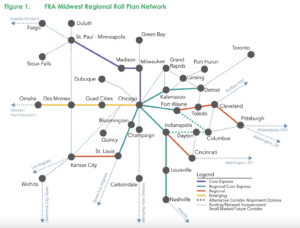Amtrak train, Chicago
May 31, 2022
Get ready! Midwest rail projects are ready to roll
Federal infrastructure funding opens soon, offering a once-in-a-generation opportunity to revamp passenger rail in the Midwest. Here's where we should start
Earlier this month, the Federal Railroad Administration announced a new federal program for intercity passenger rail. It’s the first step in distributing $30 billion in new rail investments established in the Infrastructure Investment and Jobs Act, creating a pipeline of corridor projects for federal funding.
In essence, states are being told “on your mark, get set…” The “go” will come later this year when the FRA solicits formal requests for projects. In the meantime, states and rail advocates need to be getting ready.

Midwest regional rail network improvements planned by the Federal Railroad Administration. Read full plan here
Here in the Midwest, there are numerous projects that are worthy of inclusion. States should be lining up at the starting line for projects like:
- Chicago–Milwaukee. With strong ridership growth, this corridor is ready for additional train frequencies. To make that happen, additional rail capacity will be needed. While local concerns have at least temporarily derailed a proposal to add that capacity in Glenview, investments in Wisconsin – including new track at the Milwaukee Airport train station – are ready to go.
- Chicago–Twin Cities. A second daily train between these cities can happen quickly, quadrupling ridership options.
- Northern Lights Express. This new corridor between Minneapolis and Duluth is ready for prime time. While legislative battles in St. Paul threaten state funding for the project, it at least belongs on a list of “pipeline” projects. And if the stalemate can be broken, new service is possible in a few short years.
- Chicago-Quad Cities. This project has languished for years, as the Illinois Department of Transportation and the Iowa Interstate Railroad have negotiated at glacial speeds over what infrastructure is necessary to bring passenger trains to these tracks. With more money available from Washington, maybe this project can finally move forward. Help bring this rail line to life by signing the Quad Cities Chamber of Commerce’s petition here.
- Chicago Union Station. At the hub of the Midwest network sits Union Station. If rail passenger growth is going to happen, then upgrades here are vital. Fortunately, Amtrak has a plan for improved flow of trains and passengers. It’s time to make it happen.
- Cleveland–Columbus–Dayton–Cincinnati. This corridor won $400 million under the Obama Administration, only to have Governor Kasich return the funds. The project is now stronger than ever, and Governor DeWine has signaled interest. Ohio would be foolish to blow this second chance.
- Chicago–Detroit. The dream of a high-speed rail corridor is not far away, as track upgrades have already improved faster speeds along some stretches of the corridor.
This list is not exhaustive, but it represents the best thinking of both states and the Federal Railroad Administration, which last October released the Midwest Regional Rail Plan – a plan that includes all these corridors as worthy of investment.
At the heart of our nation’s transportation infrastructure, the Midwest is a perfect place for passenger rail improvements. Our accommodating terrain and well-spaced cities mean that even modest investments can easily serve millions. Modern trains with innovative technology are the most efficient way to move groups of people, helping to to reduce vehicle pollution and improve mobility options. Now is the time to seize the opportunity and invest in clean transportation solutions that will benefit our region for years to come.


